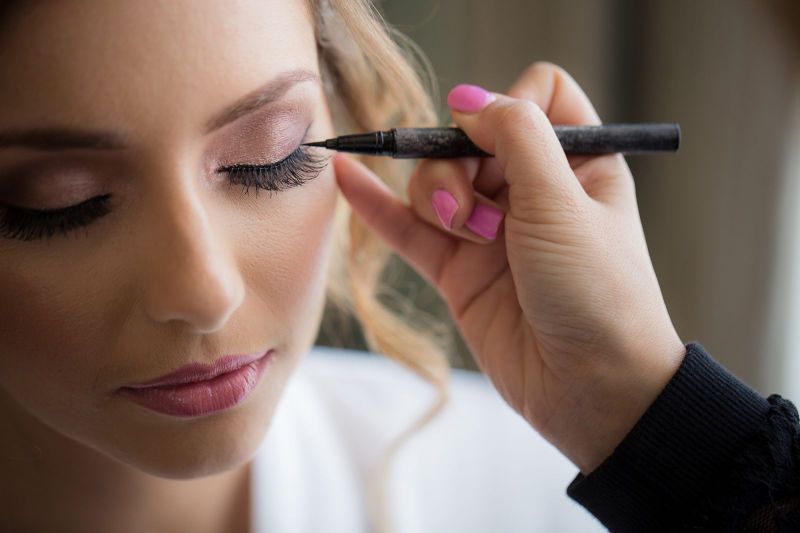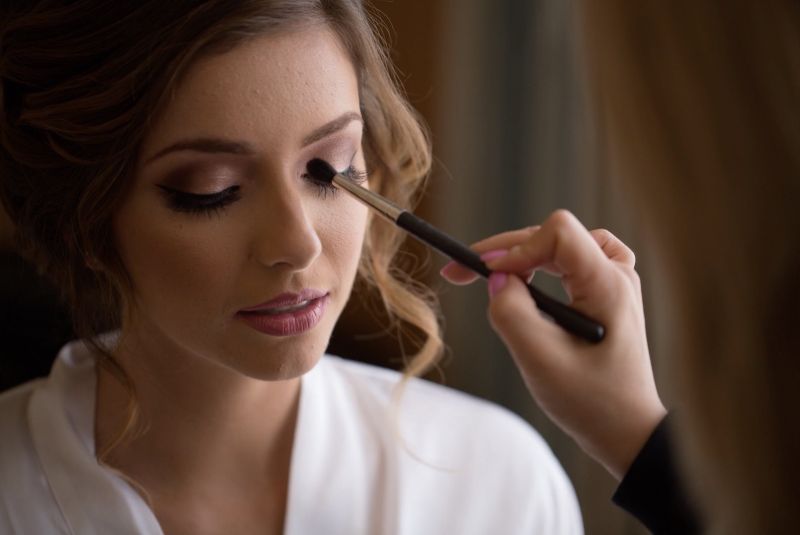
Makeup photography is an art form that focuses on photographing the entire makeup process and experience, not just the finished product. That said, the process usually consists of three parts. First, makeup shots can include “before” images, which showcase the subject or model prior to the makeup application. It can also include photos of the actual makeup application. When photographing bridal prep, this second phase usually happens out of sequence as the makeup artist pretends to apply makeup to an already perfectly made-up face. This ensures the bride looks her best on her big day, even during the “prep” phase. Lastly, as you might imagine, makeup photography includes the actual “after” photos when the entire process is complete.
Who Are Makeup Photography Clients?
As a photographer, you might be asked to capture makeup photography for makeup artists or their clients.
Makeup Photography for Makeup Artists
Makeup artists create art with every one of their subject’s faces. They use various techniques, such as blending colors together, contouring features and changing the look of lips and eyes to create perfect looks for their models. The process is often quite intricate and detailed, requiring proper lighting, camera settings and control over the finished look in order to achieve perfect results. Makeup artists will likely use these images on their website and social media accounts to attract new clients. For this reason, it’s important that photos of their work look incredible.
Makeup Photography for Commercial Brands + Concepts
There is no doubt that makeup photography has become an integral part of today’s fashion world. You’ll frequently find makeup photography used in fashion “look books” for designers as well as makeup product ad campaigns. You might also find makeup-centric pics in creative editorial projects that aim to capture specific looks or concepts.
Makeup Photography for Brides

Bridal prep is an integral part of the wedding day that many brides want photographed. It offers wedding photographers an opportunity to capture candid shots of the bride with her bridal party as they spend their morning together, getting ready (having makeup applied), sharing celebratory toasts, and generally enjoying some “private” time together before the festivities really get going.
Makeup Photography Tips
This unique type of photography requires technical expertise as well as an understanding of how lighting and expressions can affect the look of the makeup. By combining artistry and technique, makeup photographers can produce flattering pictures that make the subject and the product look amazing. Here are some tips from our Photographing the Bride workshop (part of our Wedding Photography Training System) that you can put to use when photographing makeup for all types of clients.
1. Make Sure that Makeup Is Important
This mostly applies to wedding photographers, but it’s important to know how much your client values makeup photos. If your client doesn’t really care for prep photos, your time could be better spent focusing on other aspects of the shoot. For wedding photographers, this could mean capturing photos of other details like wedding rings, invites, and the wedding wardrobes while the client gets ready. If possible, you should still snap a couple “fakeup” shots (covered below) for the makeup artist to use. Taking shots that help other vendors provides a great way to build relationships and network within the industry.
2. Be Respectful of MUA/Hair Artists
The makeup artist may not be your makeup photography client, but you should still treat them with the utmost respect. The last thing you want to do is walk in and start moving the client or makeup artist’s products around without first consulting with the makeup artist. For example, you might notice a spot with perfect natural light for capturing makeup photos, but don’t assume the makeup artist is okay with the move. Chances are, he or she will gladly accommodate your request, but there might also be a reason the makeup artist chose to place the subject where you found them.

The same holds true if the makeup artist’s station is messy. Ask if they’re okay with moving some of their kit out of frame before jumping in and doing it yourself. Again, they want the makeup photography shots to look great as well, so they’ll most likely work with you to make that happen.
3. Place Subject in Good Light (If Possible)

The ultimate goal is to make your subjects look their best. This means you’ll want to place them in good light with clean backgrounds whenever possible. If you follow step two and get the makeup artist’s permission to move your subject, try to find a clean area with flattering light that also allows you to move around and capture different angles. Large windows with sheer curtains make great natural light sources, and you can typically find them in hotel rooms. If the natural light on-location doesn’t cut it, consider using off-camera flash, either bouncing off the ceiling or firing through a carefully placed softbox.
Check out our Photographing the Bride workshop for more tips on lighting bridal prep, or our Flash Photography Training System for a comprehensive collection of flash photography concepts and techniques.
4. Remember the Storytelling Formula of Wide, Medium, and Tight for Makeup Photography

Like other genres, makeup photography benefits from a storytelling approach. If you recall watching your favorite movies or TV shows, they typically follow a wide, medium, and tight formula. In other words, the scene will open with a wide angle shot to establish the location. Next, the camera will move into a medium shot to reveal the subjects in a scene. Finally, closeup shots allow the viewers to see the subject’s expressions and other details. When you include this storytelling approach in your makeup photography, you make it easy to design effective album spreads and wall art clusters that your clients will appreciate.
5. Shoot from His or Her “Good” or Preferred Side
Most, if not all, of your clients will likely have a preferred side, or the side of their face/body that they prefer to feature in photographs. Many people call this their “good” side, but this implies the other side is “bad.” We recommend calling it their preferred side, and you should ask your clients which–if any–side they prefer to feature in photos. This tip applies to all types of portrait photography, not just makeup photography.
6. Include the MUA & Hair Artists in Your Images

We mentioned shooting with storytelling in mind earlier in the article. In addition to shooting from wide, medium, and tight (closeup) angles, including relevant “characters” in your scene gives the scene more context and makes for a better picture. When doing makeup photography, the makeup artist plays a pivotal role and should be included in at least some of the shots. Unless your client despises the makeup artist, which is unlikely, he or she will probably appreciate having the makeup artist in the photos. It all adds up to help bring the day back to life when viewing the photos years later.
7. Do “Fakeup” when Needed

Here’s a little makeup photography industry secret. For clients who don’t value the process as much as the final product, “fakeup” (or fake makeup) photos allow you to capture clients looking their best in what appear to be process shots, even though the makeup is actually fully applied. In order to do fakeup photos, wait until the makeup artist has finished applying the makeup, and then have him/her pretend to apply the makeup while you capture a few shots (wide, medium, and tight) of the fake process. More often than not, when you ask the makeup artist to do fakeup shots, they’ll already know what you’re talking about. If not, simply let them know what you need.
8. Conclude with Headshots

For the grand finale, it’s time to show off the makeup artist’s work with beautiful, flattering headshots. You can light these a number of ways, using natural light or flash. At the end of the day, the goal is to highlight the makeup in a flattering way that the makeup artist and your subject will appreciate and want to share.
If you’d like more insight into the art of headshot photography, be sure to check out our dedicated workshop on the topic.
Makeup Photography Inspiration and Examples
Here are some more makeup photography examples to inspire your own sessions.










Get Connected!